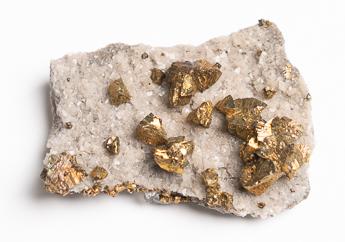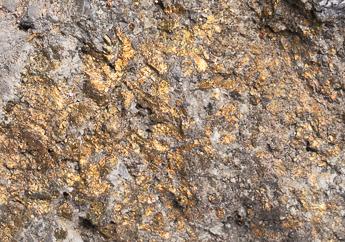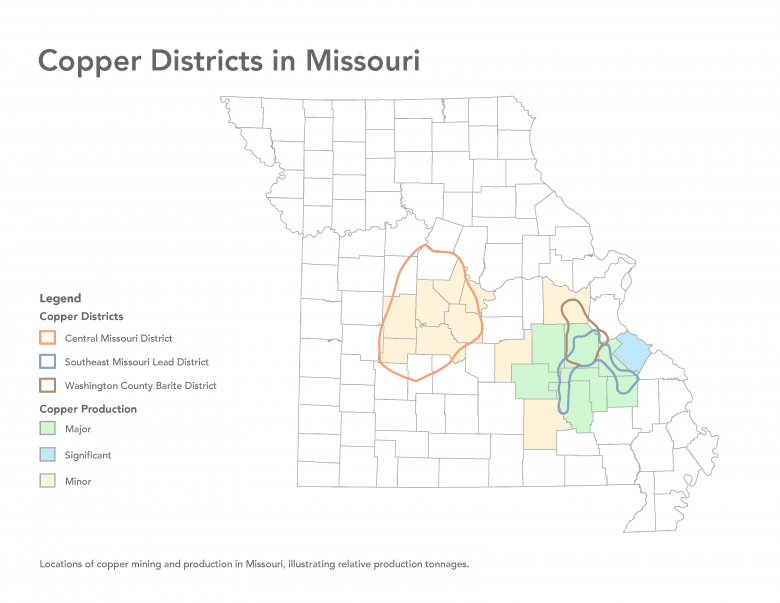
Commodity

Copper is a soft, malleable, copper-colored metal known for its ability to conduct electricity. Current production in Missouri is from multiple mines in the southeastern part of the state, where it is found associated with lead, zinc and silver. Copper was named from "cuprum," the Latin word for the island of Cyprus, a major copper producer both in ancient times and today. Discovery and use of copper dates to human prehistory. Exact timing of the first use of the metal is unknown, but copper beads have been found that date to 9,000 B.C., and the metal was being smelted from ores by approximately 5,000 B.C.
In Missouri, copper is recovered from two primary ore minerals. Chalcopyrite (CuFeS2) is found as massive mineralization, and also occurs as small distinctive crystals. Bornite (Cu5FeS4) is most often found as massive material; crystals of bornite are rare. Both ores are currently are mined for copper in Missouri. Two other copper minerals, malachite (Cu2(CO3)(OH)2) and azurite (Cu3(CO3)2(OH)2) were historically produced in minor amounts.
Economic Importance
Most copper produced currently and historically in the state has been as a byproduct from lead and zinc mines in southeast Missouri. The state became a significant producer of the metal in the late 1960s with the beginning of production from mines in the Viburnum Trend. The metal also was produced from other lead-dominant deposits in southeast Missouri, especially in the Mine LaMotte-Fredericktown area. Smaller copper-dominant deposits were mined in Ste. Genevieve County from 1863 to 1888 in the Cornwall Copper mines area, and in Shannon County from 1838 to the late 1920s.
Missouri ranks number seven in copper production in the U.S. (U.S. Geological Survey, 2020) and has recorded copper production since the 1830s. Total copper production in Missouri equals nearly 600,000 tons. Based on 2018 prices, Missouri copper has produced more than $3.6 billion dollars of value throughout its history. While the tonnages do not match those of lead and zinc, copper has been an important addition to Missouri's mineral wealth.
Copper Ore Minerals in Missouri
Chalcopyrite
- Chemical composition: CuFeS2.
- Color and Luster: Brass yellow; may develop an iridescent tarnish. Metallic luster.
- Hardness: 3.5 to 4.
- Cleavage: cleavages are poor and indistinct, and not useful for identification.
- Specific gravity: 4.1 to 4.3.
- Crystal system: Tetragonal crystal system; crystals are common in some deposits.
- Named from the Greek words "chalkos" for "copper" and "pyrites" for "strike fire."
Bornite
- Chemical composition: Cu5FeS4.
- Color and Luster: Tan to brown on fresh surface, tarnishes to iridescent purple. Metallic luster.
- Hardness: 3.
- Cleavage: cleavages are poor and indistinct, and not useful for identification.
- Specific Gravity: 5.5 to 6.
- Crystal system: Orthorhombic. Crystals are rare in Missouri.
- Bornite initially had a number of informal names, but was eventually named for von Born, an Austrian mineralogist.
Malachite
- Chemical composition: Cu2(CO3)(OH)2.
- Color and Luster: Bright green. Missouri samples are often dull or earthy in luster, but may be adamantine, vitreous, or silky.
- Hardness: 3.5 to 4.
- Cleavage: crystals have 1 perfect cleavage.
- Specific Gravity: 3.6 to 4.
- Crystal system: Monoclinic, but crystals are rare in Missouri.
- Named "molochitus" by Pliny the Elder after the Greek "mallows" for the similarity of the color to mallow leaves, but known by malachite by the mid-1600s.
Azurite
- Chemical composition: Cu3(CO3)2(OH)2.
- Color and Luster: Often azure blue but varies from light to dark blue. Vitreous luster.
- Hardness: 3.5 to 4.
- Cleavage: crystals have 1 perfect.
- Specific Gravity: 3.8.
- Crystal system: Monoclinic. Crystals are rare in Missouri.
- Azurite is from the ancient Persian "lazhward" (blue).
Common Names
Chalcopyrite is sometimes called “copper pyrite” due to its similar appearance to the mineral pyrite (iron sulfide, FeS2). Bornite is often known as "peacock ore" due to the extensive purple to dark blue tarnish that develops on exposed surfaces.
Primary Uses

Copper is used for many different purposes. Construction is the largest consumer, where it is an integral component of electrical wiring, plumbing and heating, air conditioning, refrigeration and building hardware. Other uses include electric and electronic products, industrial machinery, brass production, and transportation equipment. The U.S. 1-cent coin, often referred to as a “copper penny,” has since 1982 contained only 2.5% copper as plating; the remaining 97.5% is zinc (U.S. Mint, 2020).
Past Uses
Use of copper extends back more than 10,000 years. It was used for early weapons, tools, jewelry, coins, food vessels, sculptures, plumbing, and alloyed with tin to create bronze. Later uses included medical sterilization, roofing, cladding for ships, engraving plates for printing presses and brass (a zinc-copper alloy).
Principal Locations of Copper in Missouri
The majority of copper production in Missouri occurred as a byproduct of lead and zinc mining in the southeastern part of the state. The Southeast Missouri Lead District is considered a world-class mining district. Other areas are notable for historic copper production, or for future copper mining potential. Minor copper mineralization is present throughout large parts of Missouri.
Southeast Missouri Lead District
- Comprises several subdistricts, of which the Viburnum Trend (1955 to present) continues to produce copper. Mine LaMotte-Fredericktown (1720-1961) produced significant copper, while the Old Lead Belt (1700s to 1972) portion produced lesser quantities.
- The Viburnum Trend underlies the counties of Crawford, Dent, Iron, Reynolds and Washington. Mine LaMotte-Fredericktown is located in Madison and St. Francois counties. The Old Lead Belt is in St. Francois County.
- This district has ensured Missouri's position as a major copper producer in the U.S. for decades.
Boss Iron-Copper Deposit, Dent and Iron Counties
- Precambrian igneous-hosted iron oxide-copper deposit with cobalt and minor gold.
- The deposit currently is not developed but has potential for future development.
- Presence of the deposit suggests other igneous-hosted deposits may have copper potential.
Cornwall Copper Mines, Ste. Genevieve County
- Produced copper from 1863 to 1888 from surface and shallow underground mines.
- Small deposits of high-grade copper ores, including chalcopyrite, malachite and azurite.
- Ores were hosted by Ordovician-age rocks.
Shannon County
- Produced copper sporadically from shallow underground mines from 1838 to the 1920s.
- Small deposits of copper ores, including chalcopyrite, malachite and azurite.
- Ore was in a conglomerate at the Precambrian-Cambrian contact.
Minor amounts of copper were also produced from filled-sink pyrite deposits in Washington and Crawford counties. Smaller-scale copper mining also occurred throughout multiple other counties in southern Missouri. While most lead and zinc deposits contained some copper, it often was not of sufficient grade for production.
Geologic Occurrence
Significant copper mineralization in Missouri is found in two very different deposit types. Mississippi Valley-type deposits are lead and zinc dominant deposits that contain copper; they have characteristic mineralization that formed in limestone and dolomite in specific geologic settings. Iron oxide-copper-gold deposits are hosted by igneous rocks and contain large quantities of the iron oxide minerals magnetite or hematite.
Chalcopyrite, bornite and other copper-bearing minerals are primarily found in Cambrian- and Ordovician-age sedimentary rocks and in Precambrian igneous rocks in southeastern Missouri. The minerals are found as minor occurrences in most geologic age rocks in Missouri.
Copper ores in sedimentary rocks in Missouri are found in limestone and dolomite. Ore minerals occur as crystals in open spaces and fractures, and as fine grains of copper-bearing minerals disseminated through and replacing the host rock. Disseminated ores comprise the majority of currently economic copper ores in Missouri.
Copper ores in Precambrian igneous host rocks in Missouri are primarily found associated with the iron oxide minerals magnetite and hematite, although some copper is found without these minerals. The mineralization is generally in rhyolite and trachyte, both volcanic igneous rocks. The copper minerals are generally fine grains disseminated with the iron oxide minerals or in the host rocks themselves. Some are found filling fractures.
Mining
Present copper production in Missouri is as a byproduct of lead and zinc mining. Current mining is entirely underground at depths as great as 1,400 feet in the Viburnum Trend portion of the Southeast Missouri Lead District. Ores are blasted, crushed, transported to the surface, crushed further, and run through flotation cells to separate the copper ore from the dolomite or limestone and other ore and non-ore minerals. Ores are then shipped to smelters and smelted to generate copper metal.
Early copper mining was of shallow or near surface ores, with mines consisting of small open pits or limited underground workings. Many of these early open pits were very small and are difficult to locate today. Some early small underground mines are still visible, although unsafe to visit. During the 1860s, developments in drilling technology lead to deeper and larger underground mines, especially in southeast Missouri, although smaller hand and shallow underground mining continued into the mid-1900s. Improvements in groundwater pumping technology in the late 1800s lead to development of larger, deeper underground mines, where copper was produced as a byproduct of lead and zinc mining.
Production History
Copper production in Missouri from 1838-2000; data for years later than 2000 are not available. Most data pre-1911 are averaged from lump sums. The increase near 1970 marks increased production from the Viburnum Trend.

References and Additional Reading
U.S. Geological Survey, 2020, Copper; U.S. Geological Survey, Mineral Commodity Summaries, p. 52-53.
U.S. Mint, 2020, Coin production; United States Mint.
Search the Missouri Geology Bibliography
Visit the department’s Ed Clark Museum of Missouri Geology, where you will find copper on display.

